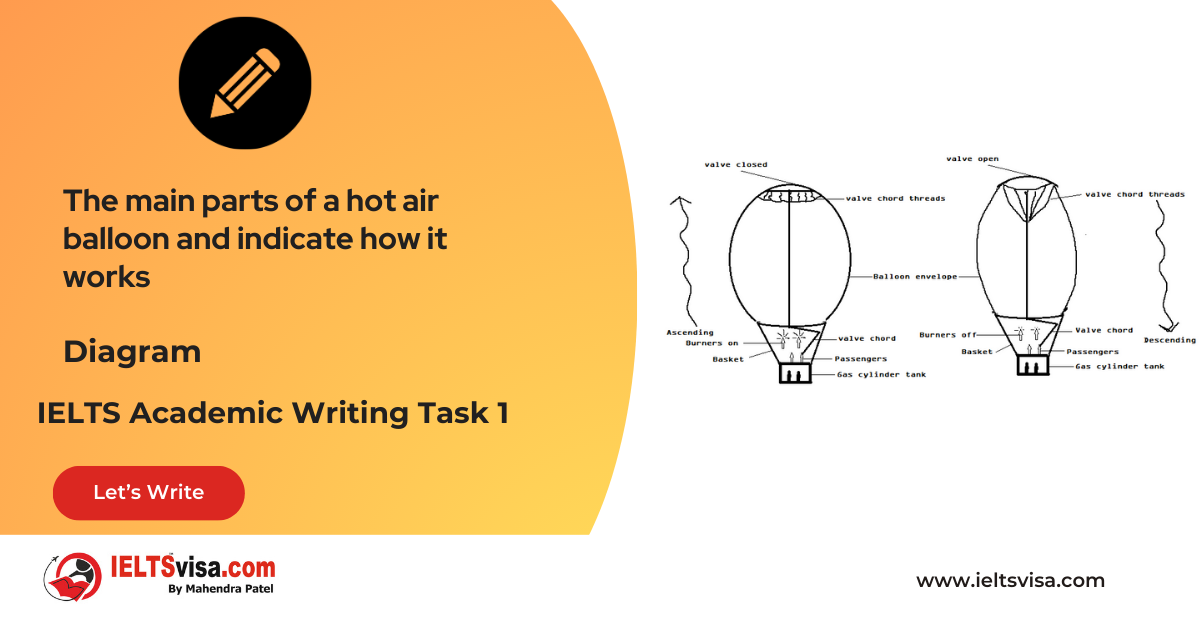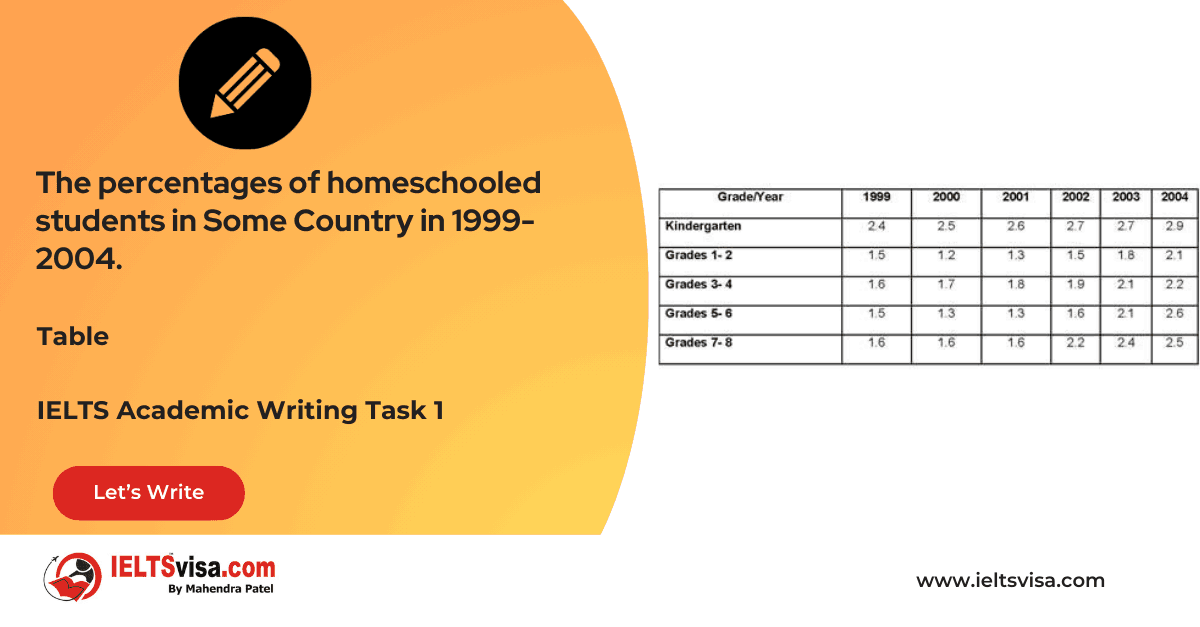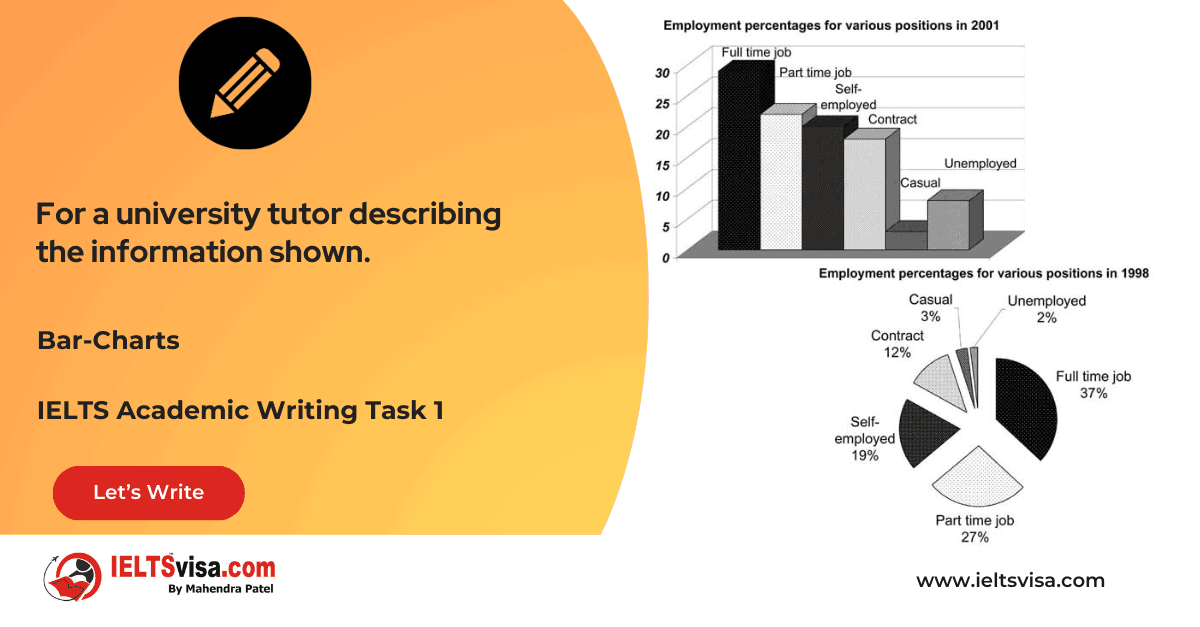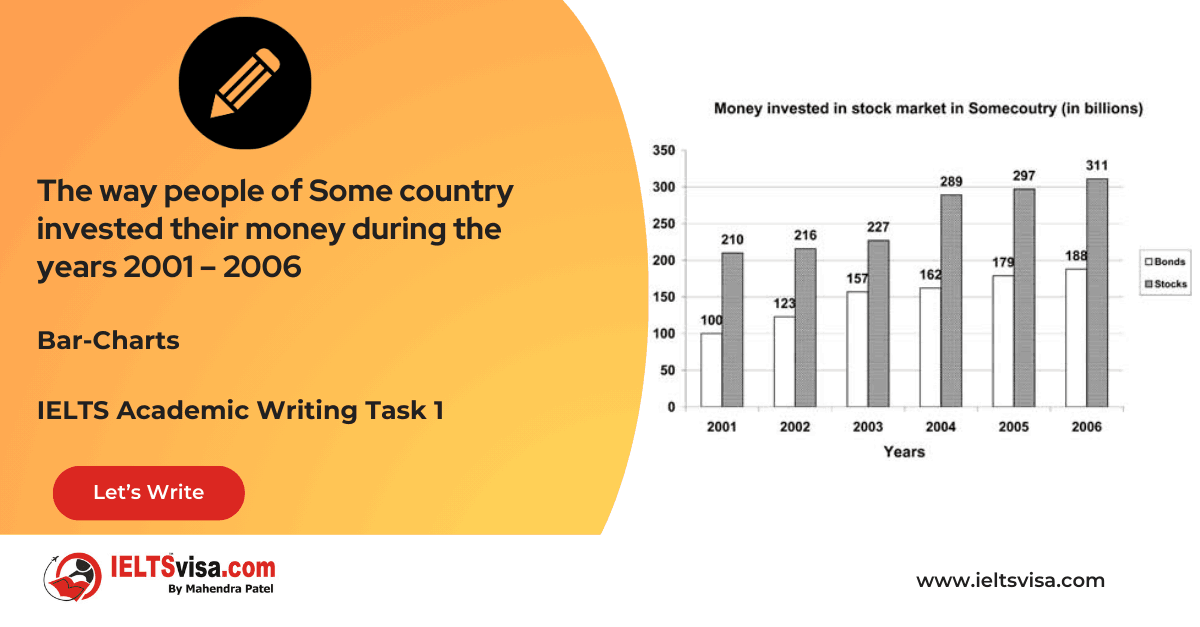Number of Working Hours per Week in the Industrial Sector (2002)
IELTS Academic Writing Task 1 - Combination Bar Graph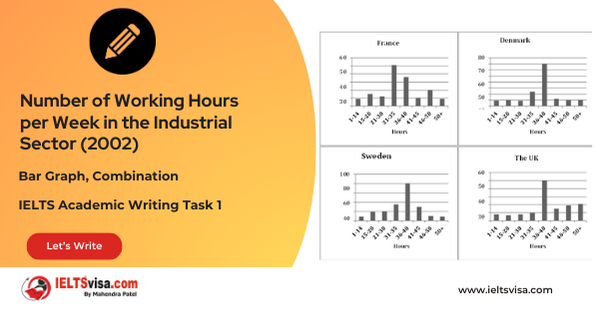
IELTS Writing Task 1 Question
The charts below show the number of working hours per week, in industrial sector, in four European countries in 2002. Summarize the information by selecting and reporting the main features and make comparisons with relevant.
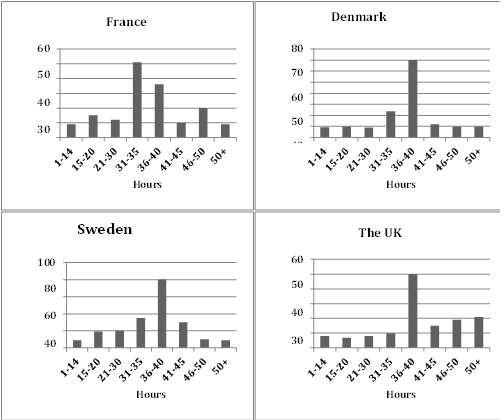
Common Questions for the Combination Bar Graph
- Graph Type: Bar Graph
- Title: Number of Working Hours per Week in the Industrial Sector (2002)
- Units of Measurement: Number of hours worked per week
- Who: Industrial workers in four European countries
- When: 2002
- Where: France, Denmark, Sweden, and the UK
- Topic: Working hours per week for industrial workers
Comparison Showing and Trends Any change over time (such as an increase or a decrease) is a trend.
Comparison 1: Working Hours in France
- Details:
1. Approximately half of the workers (50%) worked 31-35 hours per week.
2. 35% worked 36-40 hours, while 20% worked 46-50 hours.
3. The remaining hours (less than 30 hours and more than 50 hours) accounted for around 10% each.
Comparison 2: Working Hours in Denmark and Sweden
-
Details:
1. Denmark and Sweden had the highest percentages of workers (36-40 hours), with Denmark at 40% and Sweden at 35%.
2. In Denmark, 25% worked 31-35 hours, while 10% worked 41-45 hours.
3. Sweden had a slightly higher percentage for 41-45 hours (30%).
Comparison 3: Working Hours in the UK
- Details:
1. The UK showed the highest percentage of workers (50+) at 10%.
2. Almost 50% of workers were engaged in the 36-40 hour range.
3. A significant number also worked less than 31 hours.
Sample Answer
The bar graphs compare the number of working hours per week for industrial workers in four European countries—France, Denmark, Sweden, and the UK—during the year 2002. The data reveals notable differences in working hour patterns among these countries.
Overall, France had the fewest working hours, while Sweden’s workers spent the most time on the job among the four countries.
In France, approximately half of the workers (50%) were engaged in 31-35 hours of work weekly, which is lower than in the other countries. Additionally, 35% worked 36-40 hours, while 20% dedicated 46-50 hours to their jobs. The remaining workers, who worked either fewer than 30 hours or over 50 hours, accounted for around 10% each.
Conversely, Denmark and Sweden exhibited a higher proportion of workers in the 36-40 hour category, with Denmark at 40% and Sweden at 35%. In Denmark, 25% of workers operated within the 31-35 hour range, whereas in Sweden, a significant 30% worked 41-45 hours.
The UK displayed the highest percentage of workers clocking over 50 hours per week, though nearly 50% were also employed for 36-40 hours.
Top 25 Vocabularies
| Vocabulary (type) | Type | Meaning | Synonyms | Examples |
| Proportion (n.) | Noun | A part or share of a whole | Percentage, ratio, fraction | “The proportion of workers in France working 31-35 hours was significant.” |
| Account for (v.) | Verb | To make up a certain percentage of a whole | Constitute, comprise, represent | “Approximately half of the workers accounted for those working 31-35 hours.” |
| Maximum (adj.) | Adjective | The most tremendous amount or level | Highest, utmost, peak | “The maximum number of workers in France worked 31-35 hours.” |
| Significant (adj.) | Adjective | Noteworthy or important | Major, considerable, notable | “The significant number of workers in the UK worked 50+ hours.” |
| Compare | Verb | To examine the similarities and differences | Contrast, correlate | “The bar graphs compare working hours in four countries.” |
| Pattern | Noun | A repeated or regular way something happens | Trend, model, framework | “The data reveals notable working hour patterns.” |
| Engaged | Adjective | Occupied or involved in doing something | Involved, employed | “50% of workers in France were engaged in 31-35 hours weekly.” |
| Dedicated | Verb | Devoted to a task or purpose | Committed, allocated | “20% dedicated 46-50 hours to their jobs.” |
| Remaining | Adjective | Still present or left after others are gone | Residual, leftover | “The remaining workers accounted for 10% each.” |
| Operated | Verb | Worked or functioned in a specific way | Worked, performed | “25% of Danish workers operated within the 31-35 hour range.” |
| Clocking | Verb | Recording or reaching a certain amount | Registering, achieving | “UK workers clocked the highest hours over 50 weekly.” |
| Range | Noun | The extent or area between two limits | Span, scope, spectrum | “Denmark had a wide range of working hour distributions.” |
| Proportionate | Adjective | Corresponding in size or amount | Equivalent, relative | “The UK showed a proportionate rise in long working hours.” |
| Reveal | Verb | To make known or show | Disclose, indicate, uncover | “The data reveals significant differences in work hours.” |
| Allocate | Verb | To distribute or assign resources | Distribute, apportion | “Workers allocated their time differently across countries.” |
| Category | Noun | A class or division of items | Group, type, classification | “Workers were divided into hour-based categories.” |
| Highest | Adjective | At the maximum or topmost level | Greatest, utmost | “The highest proportion worked 36-40 hours weekly in Sweden.” |
| Operate | Verb | To function or work | Work, run, perform | “25% of workers operated within the 31-35 hour range.” |
| Dedicate | Verb | To devote time or resources to something | Commit, allocate | “20% of workers dedicated over 46 hours to work.” |
| Exhibit | Verb | To display or show clearly | Demonstrate, display | “France exhibited the lowest working hours.” |
| Employment | Noun | The state of having a job | Work, occupation, job | “Employment patterns varied significantly among countries.” |
| Variation | Noun | A difference or deviation | Change, alteration, divergence | “There was a variation in work hours across countries.” |
| Majority | Noun | The greater number or part | Most, bulk, predominance | “The majority of workers in France worked 31-35 hours.” |
| Predominant | Adjective | Present as the strongest or main element | Main, primary, prevailing | “36-40 hours was the predominant range in Denmark.” |

Our Books
Master IELTS Speaking Part 1
IELTS Writing Task 1 Book
IELTS Writing Task 2 Book
Practice IELTS Other Modules
IELTS Listening
The IELTS Listening test assesses how well you can understand spoken English in various contexts. It lasts about 30 minutes and is divided into four sections with a total of 40 questions. The listening tasks become increasingly difficult as the test progresses.
IELTS Academic Reading
The IELTS Academic Reading section assesses your ability to understand and interpret a variety of texts in academic settings. It is designed to evaluate a range of reading skills, including skimming for gist, reading for main ideas, reading for detail, understanding inferences, and recognizing a writer's opinions and arguments.
IELTS Speaking
The IELTS Speaking test assesses your ability to communicate in English on everyday topics. It lasts 11-14 minutes and consists of three parts: introduction, cue card, and a discussion based on the cue card topic.
IELTS General Reading
IELTS General Reading tests your ability to understand and interpret various types of texts. Here are some key areas and types of content you can expect to encounter in the reading section, along with tips for effective preparation.
IELTS Academic Writing Task 1
In IELTS Academic Writing Task 1, you are presented with a visual representation of information, such as graphs, charts, tables, or diagrams, and you are required to summarize, compare, or explain the data in your own words.
IELTS General Writing Task 1
In IELTS General Writing Task 1, you are required to write a letter based on a given situation. The letter can be formal, semi-formal, or informal, depending on the prompt. Here’s a breakdown of the key components to include in your letter
IELTS Academic Writing Task 2
In IELTS Academic Writing Task 2, you are required to write an essay in response to a question or topic. Here’s a guide to help you understand the essential elements of this task
IELTS Exam Tips
To succeed in the IELTS exam, practice regularly, familiarize yourself with the test format, improve your vocabulary, develop time management skills, and take mock tests to build confidence.
Grammer for IELTS
Grammar is the foundation of effective communication in English. Understanding tense usage, subject-verb agreement, and sentence structure enhances clarity and coherence in writing and speaking.
Vocabulary for IELTS
Vocabulary plays a crucial role in the IELTS (International English Language Testing System) exam, especially in the Speaking and Writing sections. Here’s an overview of why vocabulary is important and how it impacts your performance
RECENT IELTS SAMPLES QUESTIONS AND ANSWERS
Task 1 – Diagram – A conference hall built in 1981 and planned for 2020
20:00 Start Pause Stop [df_adh_heading title_infix="IELTS Writing Task 1 Question" use_divider="on"...
Task 1 – Table – The percentages of homeschooled students in Some Country in 1999-2004.
20:00 Start Pause Stop [df_adh_heading title_infix="IELTS Writing Task 1 Question" use_divider="on"...
Task 1 – Table – For a university tutor describing the information shown.
20:00 Start Pause Stop [df_adh_heading title_infix="IELTS Writing Task 1 Question" use_divider="on"...
Task 1 – Bar-Charts – The way people of Some country invested their money during the years 2001 – 2006
20:00 Start Pause Stop [df_adh_heading title_infix="IELTS Writing Task 1 Question" use_divider="on"...
Task 1 – Diagram – Rainwater Harvesting and Conversion to Drinking Water in an Australian Town.
20:00 Start Pause Stop [df_adh_heading title_infix="IELTS Writing Task 1 Question" use_divider="on"...
Task 1 – Column graph – Percentage of Young People Enrolled in Universities in 2000 and 2007.
20:00 Start Pause Stop [df_adh_heading title_infix="IELTS Writing Task 1 Question" use_divider="on"...

